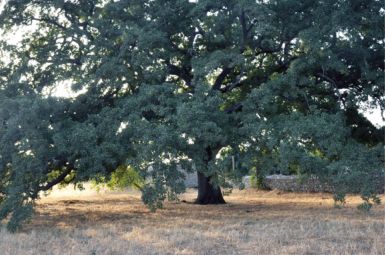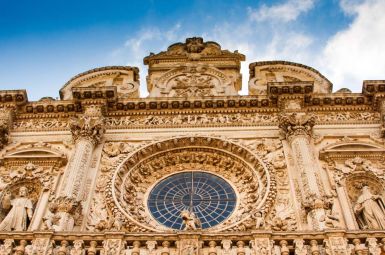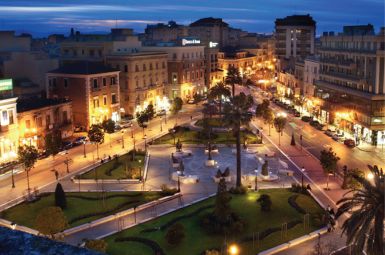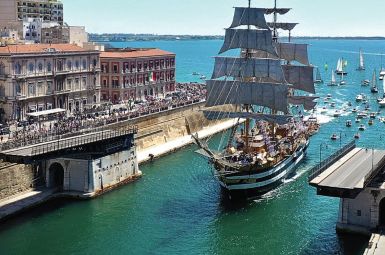
Casertavecchia
Il Borgo di Casertavecchia
Casertavecchia: Il Viaggio nel Tempo in Campania
Dimenticate il clamore della Reggia di Caserta. A soli dieci chilometri di distanza, arroccato sui Monti Tifatini a oltre 400 metri di altezza, si cela un’autentica capsula del tempo: Casertavecchia. Questo borgo medievale, il cui nome originario, Casahirta, evocava un “villaggio aspro o posto in alto”, è il cuore storico e l’anima silente di un territorio che fu culla di contee e sede vescovile. Casertavecchia non è solo un panorama mozzafiato sulla pianura: è un’esperienza sensoriale, dove le pietre dei vicoli raccontano secoli di storia longobarda, normanna e sveva, e l’aria fresca della montagna è intrisa di leggende.Il Triumvirato Architettonico: Duomo, Campanile e Castello
Il nucleo di Casertavecchia è dominato dalla Piazza Vescovado, un palcoscenico di architettura medievale che esprime l’apice del suo antico splendore.1. La Cattedrale di San Michele Arcangelo
Costruita tra il 1113 e il 1153, la Cattedrale è un capolavoro di fusione culturale. La sua architettura è un affascinante intreccio di stili: l’austero romanico-pugliese della facciata si mescola con influenze arabo-siciliane e benedettine.- Dettagli da Ammirare: L’interno, a tre navate, poggia su antiche colonne che, secondo una suggestiva leggenda locale, furono trasportate fin qui dalle fate dei Monti Tifatini. Imperdibile la Cupola Ottagonale, un gioiello di tarsie policrome e archetti intrecciati.
2. Il Campanile Gotico
Accanto al Duomo svetta l’imponente Campanile, risalente al 1234. Con i suoi 32 metri di altezza, è un punto di riferimento visivo per tutta la piana. La sua struttura è scandita in cinque piani, con splendide bifore decorate che ne accentuano la verticalità gotica.3. La Torre dei Falchi e il Castello
Al margine del borgo, a guardia della vallata, si ergono i resti dell’antico Castello Longobardo (risalente all’861), fortificato poi dai Normanni e dagli Svevi. Il simbolo più maestoso è il Maschio, noto come la Torre dei Falchi. Questa torre, tra le più grandi d’Europa, un tempo ospitava il signore e si erge come un eterno baluardo medievale, richiamando alla mente storie di assedi e di fantasmi, come quello della Contessa Siffridina che, si narra, vaga ancora tra le mura.I Tesori Nascosti e il Folklore
Casertavecchia è un luogo che si scopre camminando, perdendosi nei suoi vicoli di pietra.- La Chiesa dell’Annunziata: Un piccolo gioiello del tardo Trecento, la cui facciata gotica, con il rosone e le monofore, offre un contrasto poetico con il portale barocco aggiunto successivamente.
- Gli Spiritelli di Casertavecchia: Tra le botteghe artigiane che ravvivano le stradine, troverete gli Spiritelli, vasetti in terracotta con facce buffe. Questi portafortuna, creati dall’artista tedesca Ursula Pannwitz, sono diventati un simbolo del borgo, unendo arte popolare e tradizione campana.
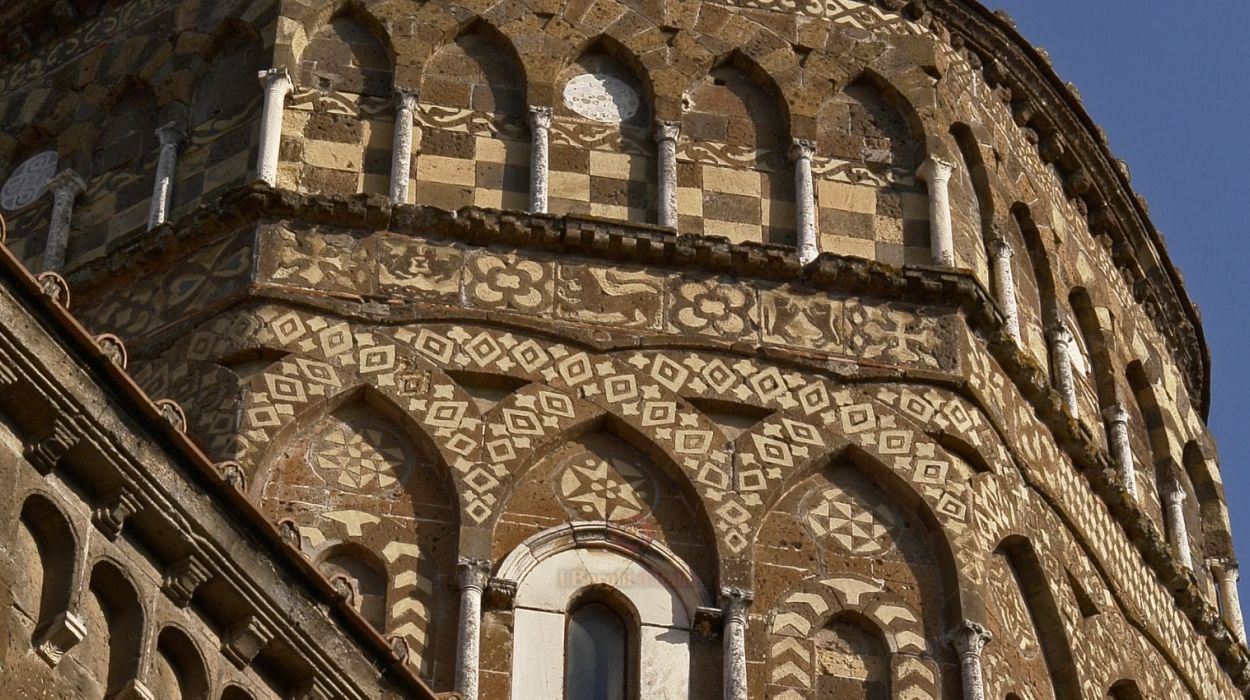
Il Borgo d’Italia
tutto da scoprire ed esplorare
Monumenti
Casertavecchia: Le Icone Medievali Sospese nel Tempo
Casertavecchia non è solo un borgo; è un monumento a cielo aperto, un’imponente fortezza di pietra che ha sfidato i secoli, arroccata sui Monti Tifatini. A differenza della vicina, sontuosa Reggia, qui l’architettura è austera, vibrante di storia e folklore. I suoi monumenti principali formano un nucleo medievale perfettamente conservato, un viaggio immediato in un passato di conti, vescovi e misteri.
1. La Cattedrale di San Michele Arcangelo: Sinfonia di Stili
Il fulcro e il simbolo spirituale del borgo è il Duomo, consacrato nel 1153. Questa Cattedrale è un affascinante manuale di storia dell’arte, dove si fondono influenze diverse in un risultato armonico e solenne.
- Fusione Culturale: La sua struttura unisce l’eleganza del romanico-pugliese e benedettino con echi esotici arabo-siculi, visibili soprattutto nelle decorazioni esterne e nell’imponente Cupola Ottagonale.
- La Leggenda delle Colonne: L’interno, a tre navate, è scandito da maestose colonne antiche. Una leggenda popolare narra che queste colonne non furono trasportate da operai, ma dalle fate dei Monti Tifatini, che vollero aiutare gli abitanti nella costruzione del loro tempio.
- Tesori Interni: Da ammirare il magnifico pulpito seicentesco, assemblato con materiali antichi, e il sarcofago monumentale del Conte Francesco della Ratta.
2. Il Campanile: Il Gigante Gotico di Pietra
Alto ben 32 metri, il Campanile si erge accanto al Duomo come un fiero custode del borgo. La sua costruzione, risalente al 1234, è un pregevole esempio di architettura gotica in Campania.
- Verticalità Decorata: La sua maestosità è data dalla scansione in cinque piani, animati da una serie di bifore elegantemente decorate con figure e teste umane, che gli conferiscono una dinamicità rara nell’architettura medievale della zona. È il punto panoramico per eccellenza, anche se oggi ne si ammira la bellezza solo dall’esterno.
3. I Ruderi del Castello e la Torre dei Falchi: La Forza del Passato
In posizione dominante, i ruderi del Castello – un tempo baluardo longobardo e poi fortificato da Normanni e Svevi – ricordano il ruolo di roccaforte strategica di Casertavecchia.
- Il Maschio e il Primato: Il monumento più iconico del complesso è la Torre dei Falchi (o Maschio), una delle torri circolari più grandi d’Europa. Era la residenza del signore e, con la sua mole, simboleggia la potenza e l’isolamento del borgo nei secoli del suo splendore.
- Misteri Sotto le Mura: L’area del Castello è intrisa di leggende, tra cui quella del fantasma della Contessa Siffridina, un’anima in pena che, si dice, vegli ancora sul borgo.
4. La Chiesa dell’Annunziata: L’Eleganza Gotica
Nascosta tra i vicoli, la Chiesa dell’Annunziata è un piccolo, prezioso gioiello della fine del Trecento. Sebbene rimaneggiata, conserva una facciata gotica di grande delicatezza.
- Dettagli Poetici: Il rosone e le slanciate monofore ogivali testimoniano l’impianto originario, offrendo un contrasto stilistico con il portale barocco aggiunto in epoca successiva.
A Casertavecchia, ogni passo sui ciottoli è un passo nella storia. Quale di questi monumenti medievali vi incuriosisce di più per una visita approfondita?
Curiosità
Casertavecchia: Leggende, Stili e Tesori Nascosti del Borgo
Casertavecchia è molto più di un borgo medievale; è una tela di storie dipinta sui Monti Tifatini. La sua bellezza senza tempo è avvolta da un fascino antico, un luogo dove la storia, l’architettura e il folklore si intrecciano in modo indissolubile. Se la “nuova” Caserta è celebre per la Reggia Borbonica, la “vecchia” è custode di segreti che risalgono a Longobardi e Normanni.
Ecco le curiosità più affascinanti che rendono Casertavecchia un’esperienza indimenticabile.
1. Il Fantasma della Contessa Siffridina: Un Amore Eterno nel Castello
Il suggestivo rudere del Castello Longobardo-Normanno è la culla di una delle leggende più toccanti del borgo. Si narra che tra le sue mura e i vicoli del paese vaghi il fantasma di Siffridina, la sfortunata moglie di Tommaso d’Aquino, Conte di Caserta.
- La Prigionia e il Dolore: Dopo la morte del marito nel XIV secolo, Siffridina fu imprigionata nel Castello di Trani dagli Angioini, ma secondo la leggenda, il suo spirito non si è mai allontanato da Casertavecchia.
- Lamenti Notturni: Si dice che nelle notti d’inverno, il suo lamento risuoni tra le rovine del castello e del Duomo, testimoniando un legame eterno e disperato con il borgo che fu la sua casa.
2. Le Colonne del Duomo e il Dono delle Fate
La grandiosa Cattedrale di San Michele Arcangelo nasconde un mito sulla sua stessa costruzione.
- Un Aiuto Soprannaturale: Le imponenti colonne che sorreggono le tre navate dell’interno provengono da un antico sito romano nella vicina piana di Calatia. La sfida di trasportare carichi così pesanti in cima al monte era enorme per l’epoca.
- La Magia dei Tifatini: La tradizione popolare ha trasformato questa difficoltà in leggenda: furono le fate dei Monti Tifatini a trasportare le colonne, portandole una ad una sulla testa, per aiutare gli abitanti a completare la loro amata Cattedrale. Un racconto che mescola fede e folklore montano.
3. Lo Stile Architettonico: Un Crogiolo di Civiltà
Il Duomo di Casertavecchia è un capolavoro architettonico proprio per la sua eterogeneità, che riflette le diverse dominazioni storiche.
- Sintesi Mediterranea: La sua struttura è un’armoniosa fusione di Romanico-Pugliese (visibile nella facciata solenne), Benedettino e soprattutto Arabo-Siculo. Quest’ultimo stile è evidente nelle decorazioni a tarsie policrome e negli archetti intrecciati della Cupola Ottagonale, un richiamo diretto all’architettura siciliana. Una vera e propria testimonianza che Casertavecchia, pur in collina, era collegata ai grandi traffici e stili del Mediterraneo.
4. Gli “Spiritelli” e la Rinascita Artigiana
Passeggiando nei vicoli, si incontra un elemento iconico del borgo: gli Spiritelli di Casertavecchia.
- L’Eredità di Ursula: L’idea di queste simpatiche figure in terracotta è legata a Ursula Pannwitz, un’artista tedesca che si innamorò del borgo negli anni ’70 e riabilitò la storica “Casa delle Bifore”.
- Portafortuna in Terracotta: Ursula iniziò a decorare vasetti e piccole suppellettili con faccine buffe e dispettose (gli spiritelli), che rappresentavano l’anima popolare e un po’ birichina del luogo. Questi oggetti, venduti nelle botteghe, sono diventati un moderno simbolo portafortuna e un emblema dell’artigianato locale.
Casertavecchia è la prova che la vera ricchezza non è sempre negli sfarzi, ma nella densità della storia e nella forza della leggenda. Quale di questi miti vi ha maggiormente affascinato?
Personaggi
Le Figure Storiche e Nobili del Borgo
Mentre la lista dei nati celebri è assente, Casertavecchia è stata il centro della vita politica e religiosa per secoli, dando dimora e luogo di sepoltura a importanti esponenti delle famiglie regnanti.
1. Francesco della Ratta: Il Conte del Duomo
Nel cuore della Cattedrale di San Michele Arcangelo, vero fulcro monumentale di Casertavecchia, riposa un personaggio storico di grande rilievo: il Conte Francesco della Ratta.
- La Memoria Eterna: Francesco della Ratta fu Conte di Caserta dal 1328 al 1359. La sua tomba monumentale all’interno del Duomo è una delle testimonianze più palpabili del potere temporale che il borgo detenne durante il Medioevo, in particolare sotto la dominazione angioina. La presenza della sua sepoltura in questo luogo sacro sottolinea l’importanza politica e strategica di Casertavecchia.
Le Figure Ispiratrici del Mito e del Folklore
Il vero patrimonio di “celebrità” di Casertavecchia risiede nelle figure che ne hanno arricchito il folklore, il mistero e l’identità culturale contemporanea.
2. Siffridina: Il Fantasma della Contessa
La figura più famosa e suggestiva legata a Casertavecchia non è una persona viva, ma un fantasma. Si tratta della Contessa Siffridina, moglie di Tommaso d’Aquino, imprigionata in un altro castello e morta lontano dal suo amato borgo.
- La Leggenda Eterna: Secondo la leggenda popolare, l’anima di Siffridina non ha mai trovato pace ed è tornata a Casertavecchia. Si narra che il suo spirito inquieto vaghi ancora oggi tra i ruderi del Castello e il Duomo, soprattutto nelle fredde notti invernali, accompagnato da lunghi lamenti che testimoniano il suo eterno legame con la fortezza sui Tifatini. Una storia che incarna perfettamente il fascino arcano del borgo medievale.
3. Ursula Pannwitz: L’Artista degli “Spiritelli”
Una figura di grande importanza per l’identità contemporanea di Casertavecchia è l’artista tedesca Ursula Pannwitz. Non nativa, ma adottiva, Ursula ha lasciato un segno indelebile nel folklore moderno.
- La Creatrice di Simboli: Trasferitasi nel borgo, Ursula recuperò l’antica “Casa delle Bifore” e diede vita agli “Spiritelli di Casertavecchia”: piccoli vasetti di terracotta decorati con facce buffe e dispettose. Questi oggetti, venduti nelle botteghe, sono diventati il souvenir e il portafortuna simbolo del borgo, testimoniando come anche una figura moderna possa incidere profondamente nella tradizione di un luogo antico.
In sintesi, Casertavecchia non celebra figure da copertina, ma custodisce i nomi di Conti medievali e figure che, attraverso la leggenda o l’arte popolare, ne mantengono vivo e unico il racconto storico.
Ricette Tipiche
Casertavecchia a Tavola: Sapori di Montagna, Tradizione Contadina
La cucina di Casertavecchia è l’espressione autentica del suo territorio: ricette robuste, nate dalla saggezza contadina e dalla ricchezza dei Monti Tifatini. A differenza della cucina di mare della costa, qui trionfano i sapori di terra, gli ortaggi spontanei e gli ingredienti semplici, sapientemente trasformati in piatti che scaldano l’anima.
Entrare in un’osteria del borgo è come sfogliare un antico ricettario, dove ogni ingrediente ha una storia e ogni piatto è una celebrazione della tradizione casertana.
I Primi e i Piatti Forti: Il Cuore della Tavola Medievale
La cucina della zona è rinomata per l’uso sapiente di legumi, verdure selvatiche e pasta fatta in casa, che conferiscono ai piatti un carattere inconfondibile e genuino.
1. Pettolelle con Fagioli (o Laganelle con Fagioli)
Questo è un caposaldo della cucina povera casertana. Le Pettolelle (o Laganelle) sono un formato di pasta fresca, simile a fettucce corte e irregolari.
- L’Essenza Contadina: Le pettolelle vengono abbinate a fagioli cannellini cucinati in umido con un leggero sugo di pomodoro e insaporiti con l’origano. È un piatto che celebra la semplicità e la completezza nutrizionale, spesso accompagnato, secondo la tradizione più antica, dagli scagliuozzi (frittelle di farina di mais) adagiati sul fondo del piatto.
2. La Menesta ‘Mmaretata (Minestra Maritata)
Sebbene tipica della Campania, la variante dei Tifatini ha un sapore distintivo. Il nome, che significa “minestra maritata,” deriva dal perfetto “matrimonio” tra la carne e le verdure amare.
- Un Matrimonio Perfetto: Si tratta di una ricca zuppa preparata con carne di maiale (cotenna, piedino o salsiccia) e un mix abbondante di verdure campane dal gusto deciso, come scarola e cicoria. Un piatto robusto e saporito, tradizionalmente legato al periodo natalizio, ma onnipresente nei menu invernali.
3. La Cianfotta
Il suo nome deriva da una parola napoletana che significa “combinazione” o “guazzabuglio”.
- Tutti gli Ortaggi del Monte: La Cianfotta è uno stufato di verdure che celebra i prodotti dell’orto e dei boschi: melanzane, patate, peperoni e, a Casertavecchia, spesso arricchita dagli asparagi selvatici che crescono abbondanti sui Colli Tifatini. È un contorno (o un secondo leggero) fresco e profumato, un inno alla stagionalità e alla varietà.
Le Delizie del Territorio e i Doni della Natura
La cucina di Casertavecchia non si limita ai piatti classici, ma si arricchisce con i prodotti unici del suo ambiente collinare.
4. Il Maialino Nero Casertano
Prodotto d’eccellenza della provincia, il Maialino Nero Casertano (una razza autoctona) è la base di insaccati di alta qualità e secondi piatti saporiti.
- Salumi Pregiati: Dai prosciutti alla pancetta e alle soppressate, le carni di questo maiale, allevato spesso allo stato brado, offrono sapori intensi e unici, spesso serviti nei taglieri delle osterie locali.
5. Asparagi Selvatici e Miele Tifatino
I boschi circostanti donano ingredienti preziosi che finiscono direttamente nei piatti.
- Frittelle di Asparagi: In primavera, gli asparagi selvatici raccolti sui colli Tifatini diventano i protagonisti di semplici ma squisite frittelle o insaporiscono primi piatti robusti come gli “Scacchi primavera”, tipici di un’antica trattoria del borgo.
- Dolcezza Naturale: Le colline sono anche un’area di produzione di miele (Acacia, Castagno, Bosco), un prodotto artigianale locale di altissima qualità che accompagna formaggi freschi o dolci tradizionali.
La gastronomia di Casertavecchia è un’esperienza che va oltre il gusto: è un viaggio attraverso la storia e la natura dei Monti Tifatini. Siete pronti a sedervi in una delle osterie medievali per degustare questi sapori antichi?
